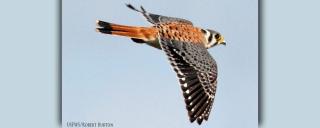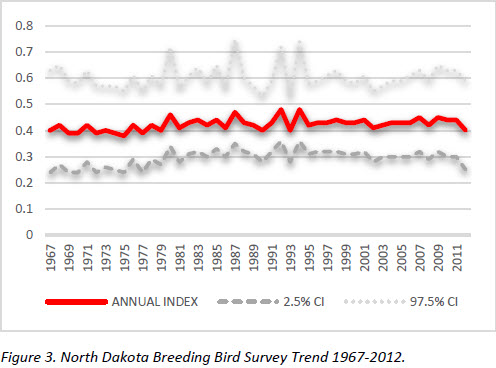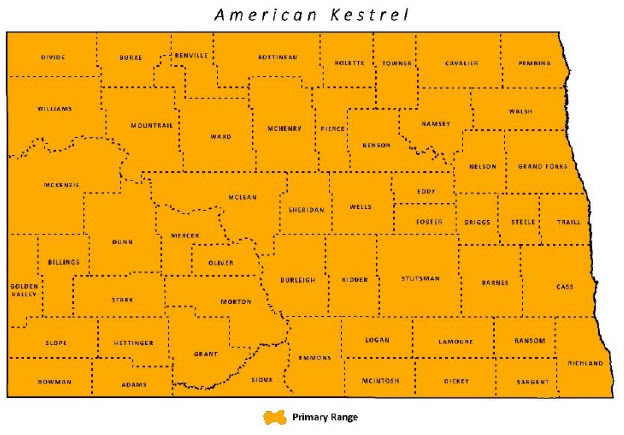
American Kestrel
| Scientific Name | Falco sparverius |
|---|---|
| General Description | L 9”, WS 22”, 4.1 oz. Small falcon, males have blue-gray wings, rust-colored back and tail, and double black stripes on face. Females are heavily barred. |
| Status | Occurs in North Dakota from mid-March to October, but occasionally seen during winter. Peak breeding season mid-April to June. |
| Abundance | Fairly common to common. |
| Primary Habitat | Open to semi-open grasslands, agricultural fields, urban areas, with suitable trees for nest cavities. |
| Federal Status | Migratory Bird. |
| Reason for Designation | American Kestrels are experiencing long-term population declines across North America. The reason for the decline is unknown. Although the population appears stable in North Dakota, careful monitoring of the species status should occur. |
Locations and Conditions of Key Habitat
Preferred Habitat
American Kestrels inhabit a variety of open to semi-open grasslands, agricultural land, badlands, and brushy margins of open woodland. Kestrels are cavity nesters and will nest in natural holes, tree crevices, or man-made nest boxes. They frequently perch on utility lines and poles. Primary prey includes large insects such as grasshoppers, beetles, dragonflies and butterflies, and in the winter will prey on mice and small birds.
Key Areas and Conditions for American Kestrels in North Dakota
No specific sites have been identified.
Habitat
Conversion of grassland to cropland, energy development and urban expansion. Removal of trees with nest cavities. Kestrels are secondary cavity nesters and the loss of woodpecker-excavated cavities or other natural cavities limits the availability of nesting sites.
Other Natural or Manmade Factors
West Nile virus, increasing competition/depredation from Cooper’s hawks, environmental contaminates, and pesticides have been suggested as possible reasons for the kestrel’s population declines. Nest abandonment is greater in higher human disturbance areas. However, the exact cause of widespread decline has not been identified.
Research and Survey Efforts
Current Research or Surveys
- Nothing specific to the species in North Dakota.
Previous Research or Surveys
- Nothing specific in North Dakota.
- Numerous published reports and gray literature on this species throughout its range.
Additional Research or Surveys Needed
Determine the effects of contaminants or insecticides on prey species.
- Demographic or life history information is lacking.
Population and Trend Estimates

- PIF Global Population Estimate: 4,000,000
- PIF North American Population Estimate: 2,200,000
- PIF North Dakota Population Estimate: 20,000
- North Dakota BBS Trend: see figure 3
- Survey-wide BBS Trend 1966-2012: -1.56
Management Recommendations
- Preserve open areas with large live and dead trees.
- When converting tree communities to grassland, leave a few individual trees or mosaic of trees.
- Construct kestrel nest boxes and place them in low human disturbance areas.
Monitoring Plans
According to the Partners in Flight Landbird Conservation Plan, long-term population trend monitoring such as the Breeding Bird Survey is generally considered adequate. Ensuring all BBS routes are conducted annually is priority. Monitoring plans should follow recommendations of the North American Bird Conservation Initiative ‘Opportunities for Improving Avian Monitoring’.
2005-2015 Progress
The American Kestrel has been added as a Level II Species of Conservation Priority.

Note: A listing of works consulted when compiling the information on this page may be found in the 2015 State Wildlife Action Plan.
